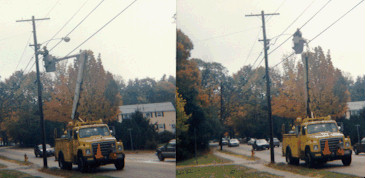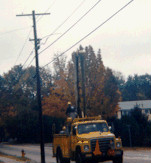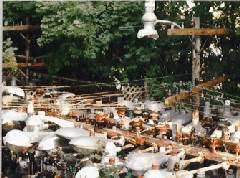

GE Form 400 Removal (Oct '93) - Joe had to put the camera down to receive the fixture!
After the removal of each nostalgic fixture, I penciled in its former location, date of removals and manufacturing date on the nameplate inside. Like the memory laners, the literally untouched lights that still had their original 1960s photocontrol and/or lamp intact were among my favorites. Interestingly, there were a fair number of these still in service. It amazes me to this day that these accessories, especially the mercury lamps were still in working condition after nearly 30 years of service. Some of these lamps were not dimmed out at night and provided an ample amount of light.


GE Form 400 Removal (Oct '93) - Joe had to put the camera down to receive the fixture!
LIGHTS, LIGHTS AND MORE LIGHTS!
Company A's streetlighting conversion lasted a couple years and by its conclusion this preservationist had quite a few fixtures on his hands! Adding to this substantial accumulation was a bunch of radial wave multiple operation incandescents that had recently come from a municipal utility. What I had acquired by 1993 was among the last surviving mercury and incandescent fixtures that were replaced by HPS in this portion of Massachusetts.
I am glad I got and saved as much as I did while the getting was good because I have had minimal access to any quantity of older lights since. Our general area is HPS now, evident at night by the "peach glow" that hangs above the skyline at night. There are still some communities in the Boston area that still have some mercury and incandescent fixtures. These are few and increasingly more of a delight to see as HPS lighting slowly seeps into some areas. In the non-HPS communities some town governments have not been able to afford HPS streetlighting upgrades. Others are some of the more affluent communities that simply do not like orange streetlights, much preferring the aesthetics of mercury and incandescent light sources. In addition, in the more wealthy towns, residents like the appearance of the Wheeler "half-moon" reflector fixtures and radial wave types that line their streets. These usually are 1960s incandescent fixtures with multiple operation lamps in them. The radial wave reflectors that can be seen are usually made of stamped aluminum. These are of the deep bowl design and have two clamps affixed to them so they can clip onto any NEMA style head. The incandescents in these towns generally are within residential areas; mercury fixtures typically run along primary roads.

THE STREET LIGHTING MUSEUM
I have been keeping my "better" fixtures from our local conversions in a dedicated museum area within my house; the remainder simply have had to be stored outside. I realized in 1993 that displaying all the stuff I had stashed outside under tarps, etc., deserved a much better second life and that properly displaying my fixtures would take a lot of ingenuity and physical effort if it was to be done correctly. This hobby is not as simple as collecting and exhibiting postage stamps and coins! So, starting in spring 1993 and laboriously continuing for the next couple years I built a private fenced in area in the back corner of my yard. This area is out of view of my neighbors and accommodates several hundred lights. This homage to streetlighting was constructed from sturdy second hand crossarms and the necessary heavy-duty hardware also accumulated during prior years as dumpster discards. Most of the fixtures on exhibit are mounted on short 1-1/4 inch diameter sections of pipe secured to horizontal crossarm runs mounted on 6-foot high posts. Others are on short yard light brackets. None of these operate except for the functional ones scattered around the yard as security lighting, as I will describe later. I made certain during the construction process that I took the proper amount of time and found the patience to overbuild everything to accommodate the weight of the fixtures on my display racks so that this exhibition will stand for a lifetime. Intermingled among my lights is a mish-mash of vintage pole line go-withs that I have collected for ages such as insulators, lightning arrestors, porcelain cutouts, etc. Hopefully by the time you read this I will have accompanied each memory lane fixture with a "dog tag" indicating the former location, when it was made, etc. Others with vintage and original lamps and photocontrols still with them will be similarly identified. Another separate fenced in area that is rather secluded for privacy houses duplicate globes, reflectors, fixtures and pipe I obtained through the years.